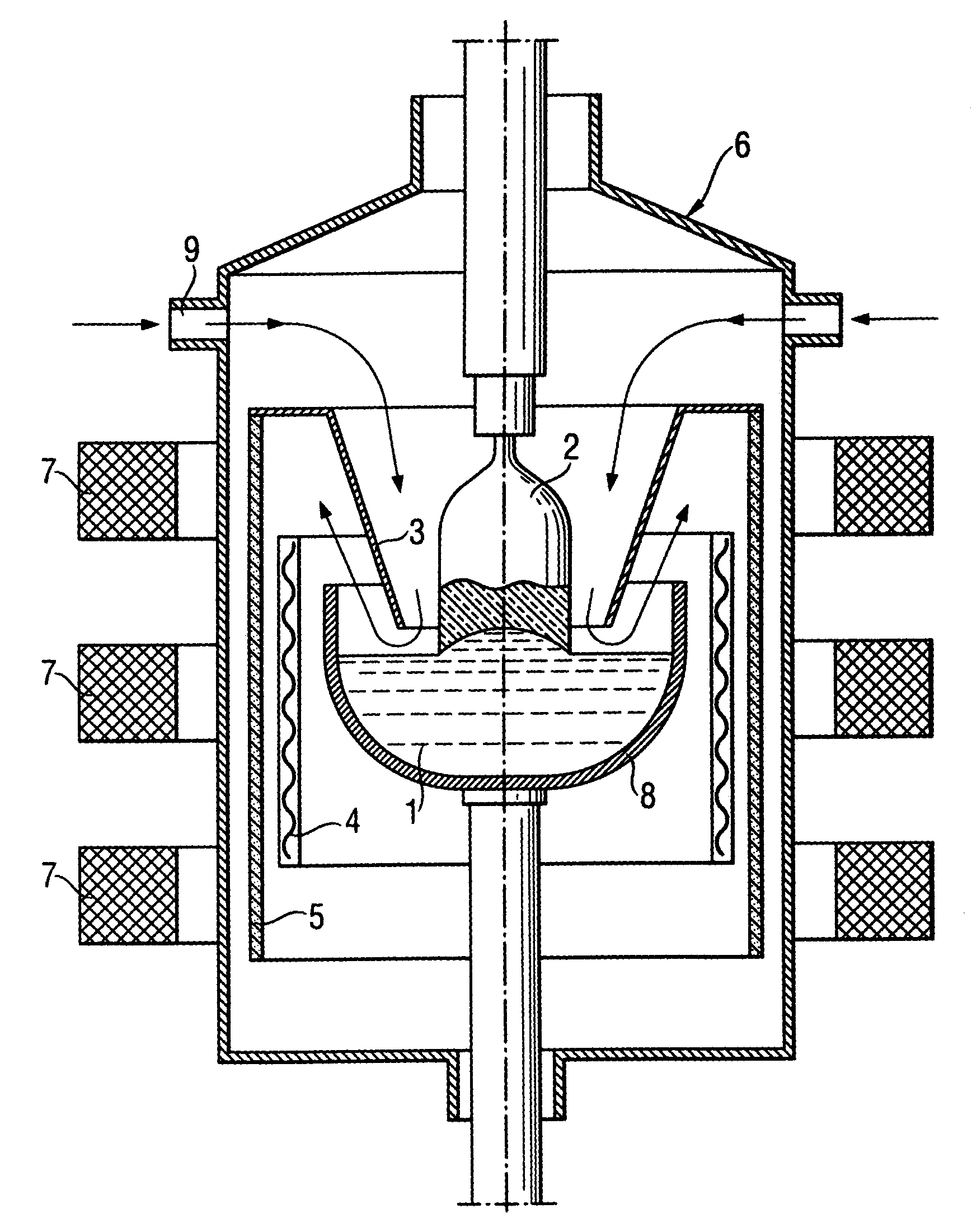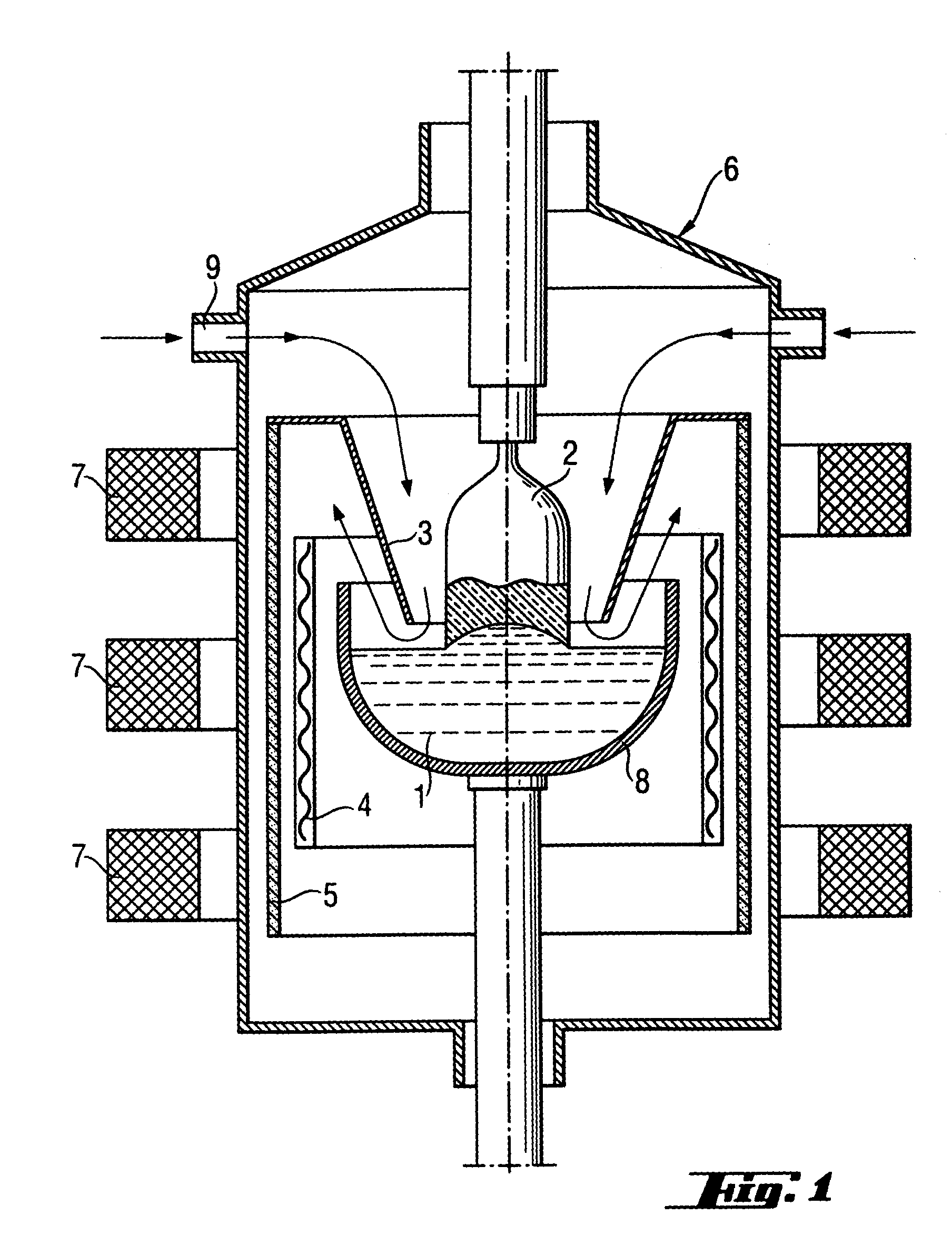Process and apparatus for producing a silicon single crystal
a technology of silicon single crystal and process, applied in the direction of crystal growth process polycrystalline material growth, etc., can solve the problem that the single crystal cannot grow in the desired cylindrical shape, and achieve the effect of increasing the temperature of the melt surface, and promoting the evaporation of sio
- Summary
- Abstract
- Description
- Claims
- Application Information
AI Technical Summary
Benefits of technology
Problems solved by technology
Method used
Image
Examples
example 1
[0023]An apparatus as shown in FIG. 1 having three coils with 36, 40 and 36 turns, connected with phase angles of 0°-120°-240°, was used. The temperature of the melt was measured using submerged thermocouples. The crucible used had a diameter of 14 inches and contained 20 kg of silicon. FIG. 2 shows how low-frequency temperature fluctuations in the melt decrease as the intensity of the magnetic field rises. An intensity of 6 mT corresponds to a current intensity of 81 A.
example 2
[0024]An apparatus as shown in FIG. 1 having three coils each with 20 turns was used. The current intensities were 350 A in each coil, corresponding to 7000 ampere turns. The quartz crucible used had a diameter of 24 inches and contained a sufficient silicon melt to allow a single crystal with a diameter of 300 mm to be pulled. Four silicon single crystals were pulled under virtually identical conditions. Only the frequency and the direction of the traveling movement of the magnetic field differed. FIG. 3 makes it clear that the inclusion of oxygen in the single crystal is considerably higher if the force generated by the magnetic field is directed downward. By contrast, a change in frequency has only a slight effect on the oxygen concentration in the silicon single crystal.
example 3
[0025]A plurality of silicon single crystals with a diameter of 300 mm were pulled under different conditions and at different pulling rates. The pulling rates were selected up to a rate which just still allowed a silicon single crystal of the desired round shape to be pulled. Four fundamentally different pulling conditions were investigated, specifically standard conditions without the application of a magnetic field; conditions under which the melt was under the influence of a static CUSP field; and conditions according to the invention with a traveling magnetic field and a force directed downward (−) or upward (+). For tests which took place under conditions according to the invention, an apparatus as shown in FIG. 1 with a coil system in accordance with Example 2 was used. In all cases, the crucible used had a diameter of 28 inches. FIG. 4 shows that the highest pulling rates can be achieved with the process according to the invention. It is most advantageous if the traveling ma...
PUM
| Property | Measurement | Unit |
|---|---|---|
| diameter | aaaaa | aaaaa |
| diameter | aaaaa | aaaaa |
| diameters | aaaaa | aaaaa |
Abstract
Description
Claims
Application Information
 Login to View More
Login to View More - R&D
- Intellectual Property
- Life Sciences
- Materials
- Tech Scout
- Unparalleled Data Quality
- Higher Quality Content
- 60% Fewer Hallucinations
Browse by: Latest US Patents, China's latest patents, Technical Efficacy Thesaurus, Application Domain, Technology Topic, Popular Technical Reports.
© 2025 PatSnap. All rights reserved.Legal|Privacy policy|Modern Slavery Act Transparency Statement|Sitemap|About US| Contact US: help@patsnap.com



